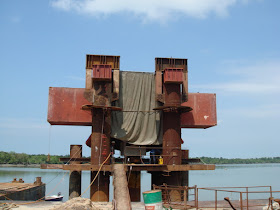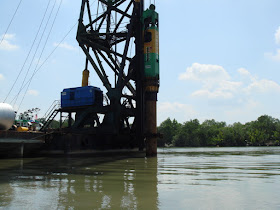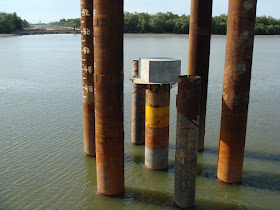In construction of bridge and building works, most of civil engineer must start and gain the common of static load test of piles. Based on previous articles i have mentioned with the method of load test using kentledge dead load which are commonly used in construction.
However there are two type of load test, namely static and dynamic load tests. Static load test generally preferred because it have been traditionally used and perceived to replicate the long term sustained load condition. while the dynamic load test are usually carried out as supplement to static load test.
In practice, load tests are more commonly conducted to determine that the foundation is capable of sustaining working loads with sufficient factor of safety. In other instances, load transfer characteristics are required to identify the mechanism by which load is transferred to the soil.
Load tests vary in their procedure, equipment, instrumentation, and load application method. There are two types of tests conducted for axial types of loading, namely compression tests and pullout (tension) tests.
For compression tests, the load can be applied either by adding dead weight or by hydraulic jacking. Direct application of dead weight can be done with concrete or steel blocks, water tanks, sand bags or any other type of weights. Method and procedure of the compression test by using kentledge method as previously article. However, the use of this method has decreased considerably, and it became more common to use hydraulic jacks to vary the load on the test pile, especially for high loading conditions.
More over by using Kentledge method it have a limit due to the higher capacity of pile introduce as ground foundation, it means more dead load to be added in order to achieve twice working load of tested pile. As Engineer, if the load test more than 400 tonne it not advisable to use the compression test because of safety aspect. Other than that, space constraint (building works), also not practical to use the kentledge method.
The alternative method commonly used in construction for Static Load Test is using pile reaction method (Tension Pile).
The objective of these test still same as kentledge method to test the settlement of the test piles except the load to be replace by 4 nos of tension piles in order to provide reaction for the applied load.
The Method Statement below for 0.6m diameter bored piles during my previous project Namely Proposed New Interchange FR1 to Proton City Project.
General
Vertical
compression pile load test is usually carried out to ensure the structural and
geotechnical soundness of pile, and to confirm that the settlement under the
test load within the specified tolerance.
The pile load test is also served as a quality control check on the
working piles.
The bored pile
as selected by the Consulting Engineer for pile load test shall be tested to
the specified maximum test load by increasing the load in stages. The maximum test load for working test pile
shall be 200% of the working load. The selected test pile shall be installed in
accordance to good normal practice and without the need of special care so as
to simulate conditions close to normal working piles.
This method
statement is intended to encompass the essential operations involved in using
tension reaction pile as alternative to concrete blocks for providing the
necessary kentledge load.
The operation
entails the following:-
1.1 confirming and setting out of tension
reaction pile positions and angle of inclination
1.2 fabrication of tension reaction pile
anchor tendon
1.3 drilling the tension reaction pile
holes and installation of tendon
1.4 concreting of bore holes
1.5 setting up of jacks and test beams
1.6 setting up of reference points and benchmarks
1.7 stressing up of tension reaction pile
anchors strands
2 Position of
Tension Reaction Pile
3 Fabrications
The tendon shall be fabricated
on a dry area with the required number of strands made up of the following
sizes and grade of strands:-
3.1 Diameter 15.7mm super grade strands of UTS 265kN
The strands tare bundled
together with tie-wire with the free length individually sheathed and greased
and the bond length unravelled. The strands shall tie to the steel cage with
wire. An extra 3 to 4 meters of strands shall be added to tendon length for
coupling onto the test beams during load test.
4 Drilling and Installation
Bored holes 600mm diameter are
to be drilled with bored piling machine to at least the minimum lengths as
shown on the drawing.
Should there be any soil
collapse during installation of tendon, the tendon shall be withdrawn and the
hole clean again. Other methods shall be used if the soil collapse is excessive
depending on site situation.
5 Concreting
Immediately after the boring for
the holes have been completed, concreting shall be carried out continuously
without interruption.
Placement of
Reinforcement and Tendons
Reinforcement with tendons to
the design requirement of tension reaction piles will be pre-fabricated in the
reinforcement yard and transported to the borehole for placing. The tendon MUST arrange and put in the central of the bore holes after
concreting.
Placement of
Concrete
Due to the anchor tendon at the
center of the bore holes, the concrete shall pour into the holes in between
tendon and reinforcement bar. Tremie concrete is a self-compacting type
concrete do not need any vibration.
Concrete cubes for testing shall
be 6 cubes/pile. Testing can be carry out once the cube achieve 70% of G30.
The work procedure for the
tension pile shall be same with the working pile installation
6 Jacks and Test Beam Set up
Jack and test beam shall be
placed centrally on the test pile as not introduce eccentricity to the pile. At
the same time, a level should be used to ensure that the test beam is placed
horizontally so as to prevent subsequent tilting or sagging of the beam during
tensioning of the anchors tendons. A typical set up with the reference beam is
as shown on the attached sketch.
7 Stressing
7.1 Before stressing the strands of the
reaction anchors the test beam shall be re-checked to ensure that it is
horizontal, and perpendicular to the hydraulic jack.
7.2 Should
the supports on which the test beam is resting on be on hard ground, the
reaction anchors can be stressed first. Otherwise, it is advisable to raise the
ram of the jack to touch the test beam before stressing.
7.3 Each
strand shall then be stressed individually and alternately by a monojack (30T
jack). The strands are stressed to ensure that they are tight and evenly
stressed.
7.4 When
all the strands are stressed, loading on the test pile shall be by the raising
the ram of the hydraulic jacks.
8 Measuring Movement of Pile Heads
The measurement
of pile movement shall be taken by using four (4) nos. dial gauges or
transducers equally spaced around the pile and equidistant from the pile
axis. Dial gauges shall be rigidly
mounted on the reference frame that bears on surfaces which are normal to the
pile axis and fixed to the pilecap or head.
The dial gauges or transducers shall be chosen to enable readings to be
made within an accuracy of 0.05mm.
At least one (1)
independent reference frame will be set up on a permanent structure or to one
(1) Y20 deformed bar driven at least 1m inside the hard ground to permit
measurement of the movement of the pile.
The independent reference frame shall be placed at a distance not less
than three (3) times pile diameters or 2m, whichever is the greater, from the
centre of the test pile, and not less than 1m from the nearest corner of the
kentledge support cribs. Check shall be made on the movement of the reference
frame and pile head relative to the external datum during the progress of the
test.
9 Equipment for Applying Load
The equipment
used for applying load will consist of one 500 ton jack Model CLR5006.. The jack shall be arranged in conjunction
with the reaction system to deliver an axial load to the test pile. The complete system shall be capable of
transferring the maximum load required for the test. Pressure gauge is
installed to record the applied load.
10 Protection of Testing Equipment
Throughout the
test period, all equipment for measuring load and movement shall be protected
from direct exposure to sunlight, wind and rain. Construction equipment and persons who are
involved in the testing process shall be kept at a sufficient distance from the
test to avoid disturbance to the measurement apparatus.
11 Records
Records shall be
kept properly during the testing period.
Load vs settlement curve shall be plotted at the site during the whole
period of the load test. Two (2) duly
signed and written summary of the pile load test results as well as the load vs
settlement curve shall be submitted to the Consulting Engineer within 24 hours
(or unless otherwise directed).
The
summary of the pile load test shall give:-
a. for each stage of loading, the
period for which the load was held, the load and the settlement recorded, and
b. Load vs Settlement curve.
The
complete schedule of recorded data and interpretation of the pile load test
results shall be submitted within seven (7) days upon completion of the test.
12 Load
Sequence
The loading sequence and duration for the pile load
test shall be followed as per specification required by consultant
13.
Preparation
of Pile Head
The pile head will be prepared in the single operation
during concrete casting to the pile.
When the concrete cast above the ground level, steel casing will be used
as pile cap for the load testing.
A layer of cement mortar will be placed on top of the
pile head to level and ensure even load distribution.
The pile reaction load test method practically use for marine works due to the logistic and safety factor. Cost for installation normally slightly cheaper than kentledge method ( for marine work) around RM 80/tonne.
Some of interesting photo for installation of Pile Reaction Load Test through my experiencing in construction.
Hope we can share the knowledge in Construction Field. Mate -ne , Sayonara.















great...interesting blog.
BalasPadamThanks for sharing with us. SECO as Shebani Electra Company is popularly called manufacture and supply technology advanced testing Instruments. Dead Weight Pressure gauge Tester & Pressure gauge Tester
BalasPadamthanking for your information hope uuu flow up this techns and commincation by me
BalasPadamengneer mohamd tantway
thanking for your best technolgy hope uuu contact
BalasPadam